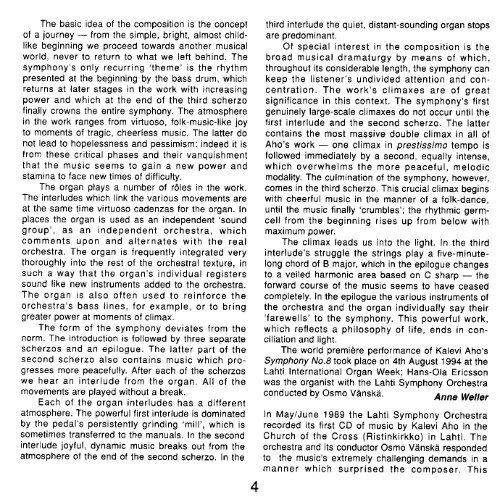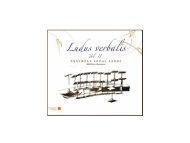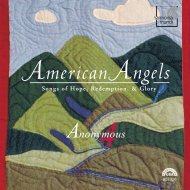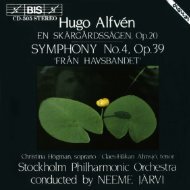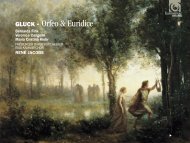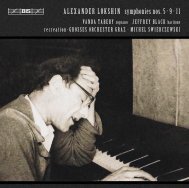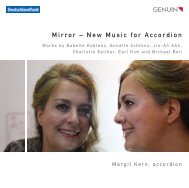Untitled - eClassical
Untitled - eClassical
Untitled - eClassical
Sie wollen auch ein ePaper? Erhöhen Sie die Reichweite Ihrer Titel.
YUMPU macht aus Druck-PDFs automatisch weboptimierte ePaper, die Google liebt.
The basic idea of the composition is the concept<br />
of a journey - lrom the simple, bright, almost childlike<br />
beginning we proceed towards another musical<br />
world, never to return to what we left behind. The<br />
symphony's only recurring'theme' is the rhythm<br />
presented at the beginning by the bass drum, which<br />
returns at later stages in the work with increasing<br />
power and which at the end of the third scherzo<br />
finally crowns the entire symphony. The atmosphere<br />
in the work ranges from virtuoso, folk-music-like joy<br />
to moments of tragic, cheerless music. The latter do<br />
not lead to hopelessness and pessimism: indeed it is<br />
from lhese critical phases and their vanquishment<br />
that the music seems to gain a new power and<br />
stamina to face new times of difficulty.<br />
The organ plays a number of roles in the work.<br />
The interludes which link the various movements are<br />
at the same time virtuoso cadenzas for the organ. In<br />
places the organ is used as an independent'sound<br />
group', as an independent orchestra, which<br />
comments upon and alternates with the real<br />
orchestra. The organ is frequently integrated very<br />
thoroughly into the rest of the orchestral texture, in<br />
such a way that the organ's individual registers<br />
sound like new instruments added to the orchestra.<br />
The organ is also often used to reinforce the<br />
orchestra's bass lines, for example, or to bring<br />
greater power at moments ol climax.<br />
The form of the symphony deviates from the<br />
norm. The introduction is followed by three separate<br />
scherzos and an epilogue. The latter part of the<br />
sec0nd scherzo also contains music which progresses<br />
more peacefully. After each of the scherzos<br />
we hear an interlude from the organ. All of the<br />
movements are played without a break.<br />
Each of the organ interludes has a different<br />
atmosphere. The powerful first interlude is dominated<br />
by the pedal's persistently grinding 'mill', third interlude the quiet, distant-sounding organ stops<br />
are oreoomrnant.<br />
Ol special interest in the composition is the<br />
broad musical dramaturgy by means of which,<br />
throughout its considerable length, the symphony can<br />
keep the listener's undivided attention and concentration.<br />
The work's climaxes are of great<br />
significance in this context. The symphony's lirst<br />
genuinely large-scale climaxes do not occur until the<br />
first interlude and the second scherzo. The latter<br />
contains the most massive double climax in all ol<br />
Aho's work - one climax in prestlsslmo tempo is<br />
followed immediately by a second, equally intense,<br />
which overwhelms the more peaceful, melodic<br />
modality. The culmination of the symphony, however,<br />
comes in the third scherzo. This crucial climax begins<br />
with cheerful music in the manner of a folk-dance,<br />
until the music finally'crumbles'; the rhythmic germcell<br />
from the beginning rises up from below with<br />
maximum Dower.<br />
The climax leads us into the light. In the third<br />
interlude's struggle the strings play a five,minutelong<br />
chord of B major, which in the epilogue changes<br />
to a veiled harmonic area based on C sharD - the<br />
forward course of the music seems to have ceased<br />
completely, In the epilogue the various instruments of<br />
the orchestra and the organ individually say their<br />
'farewells'<br />
to the symphony. This powerful work,<br />
which reflects a philosophy of life, ends in conciliation<br />
and lighl.<br />
which is<br />
sometimes transferred to the manuals. In the second<br />
interlude joyful, dynamic music breaks out from the<br />
atmosphere of the end of the second scherzo. In the<br />
4<br />
The world premidre Derformance of Kalevi Aho's<br />
Symphony No.8 look place on 4th August 1 994 at the<br />
Lahti International Organ Week; Hans-Ola Ericsson<br />
was the organist with the Lahti Symphony Orchestra<br />
conducted by Osmo Vanska.<br />
Anne Weller<br />
ln May/June 1989 the Lahti Symphony Orchestra<br />
recorded its first CD of music by Kalevi Aho in the<br />
Church of the Cross (Ristinkirkko) in Lahti. The<br />
orchestra and its conductor Osmo Vanske responded<br />
to the music's extremely challenging demands in a<br />
manner which surprised the composer. This


